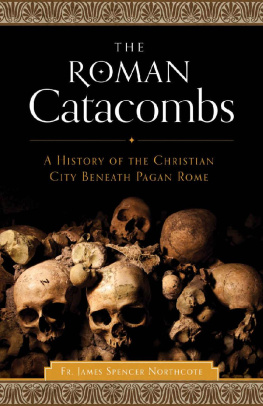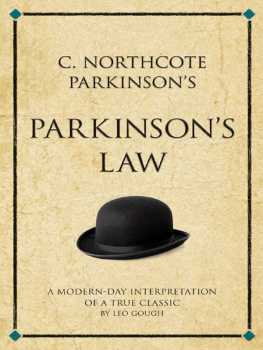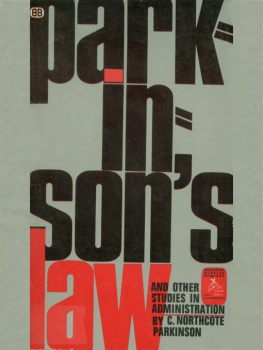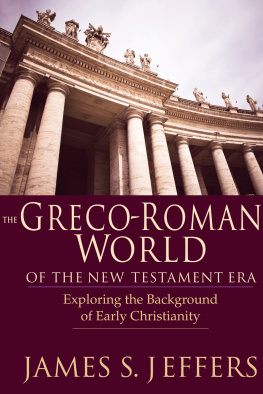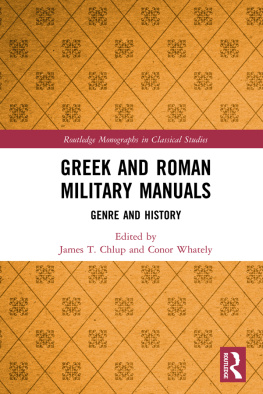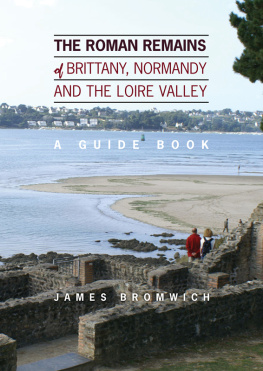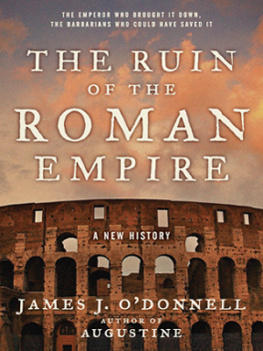Rev. James Spencer Northcote - The Roman Catacombs
Here you can read online Rev. James Spencer Northcote - The Roman Catacombs full text of the book (entire story) in english for free. Download pdf and epub, get meaning, cover and reviews about this ebook. year: 2017, publisher: Sophia Institute Press, genre: Religion. Description of the work, (preface) as well as reviews are available. Best literature library LitArk.com created for fans of good reading and offers a wide selection of genres:
Romance novel
Science fiction
Adventure
Detective
Science
History
Home and family
Prose
Art
Politics
Computer
Non-fiction
Religion
Business
Children
Humor
Choose a favorite category and find really read worthwhile books. Enjoy immersion in the world of imagination, feel the emotions of the characters or learn something new for yourself, make an fascinating discovery.
- Book:The Roman Catacombs
- Author:
- Publisher:Sophia Institute Press
- Genre:
- Year:2017
- Rating:5 / 5
- Favourites:Add to favourites
- Your mark:
- 100
- 1
- 2
- 3
- 4
- 5
The Roman Catacombs: summary, description and annotation
We offer to read an annotation, description, summary or preface (depends on what the author of the book "The Roman Catacombs" wrote himself). If you haven't found the necessary information about the book — write in the comments, we will try to find it.
The Roman Catacombs — read online for free the complete book (whole text) full work
Below is the text of the book, divided by pages. System saving the place of the last page read, allows you to conveniently read the book "The Roman Catacombs" online for free, without having to search again every time where you left off. Put a bookmark, and you can go to the page where you finished reading at any time.
Font size:
Interval:
Bookmark:
R EV. J AMES S PENCER N ORTHCOTE, D . D .
THE
Roman
Catacombs

A H ISTORY OF THE C HRISTIAN C ITY B ENEATH P AGAN R OME
SOPHIA INSTITUTE PRESS
Manchester, New Hampshire
Copyright 2017 by John L. Barger
The Roman Catacombs was originally published in 1877 by Burns and Oates, London, under the title A Visit to the Roman Catacombs . This 2017 edition by Sophia Institute Press includes minor revisions.
Printed in the United States of America. All rights reserved.
Cover and interior design by Perceptions Design Studio.
On the cover: Human skulls inside Paris Catacomb (85689508)
Bucchi Francesco / Shutterstock.com.
Biblical references in this book are taken from the King James Version.
No part of this book may be reproduced, stored in a retrieval system, or transmitted in any form, or by any means, electronic, mechanical, photocopying, or otherwise, without the prior written permission of the publisher, except by a reviewer, who may quote brief passages in a review.
Sophia Institute Press
Box 5284, Manchester, NH 03108
1-800-888-9344
www.SophiaInstitute.com
Sophia Institute Press is a registered trademark of Sophia Institute.
Library of Congress Cataloging-in-Publication Data
Names: Northcote, J. Spencer (James Spencer), 1821-1907, author.
Title: The Roman catacombs : a history of the Christian city beneath pagan
Rome / Rev. J. Spencer Northcote, D.D.
Other titles: History of the Christian city beneath pagan Rome
Description: Manchester, New Hampshire : Sophia Institute Press, [2017] |
Originally published: Lonndon : Burns and Oates, 1877. | Includes
bibliographical references.
Identifiers: LCCN 2016039472 | ISBN 9781622823796 (pbk. : alk. paper) 9781622823502 (ePub ISBN)
Subjects: LCSH: Catacombs Rome. | Christian antiquities Italy Rome. | Rome
(Italy) Cemeteries.
Classification: LCC DG807.4 .N64 2017 | DDC 945.6/3201 dc23 LC record available at https://lccn.loc.gov/2016039472
CONTENTS
Biographical Note:
P ART O NE
Chapter One
THE ORIGIN OF THE CATACOMBS

he great St. Jerome, writing about fifteen hundred years ago, tells us that when he was a schoolboy in Rome, he used to go every Sunday, in company with other boys of his own age and tastes, to visit the tombs of the Apostles and martyrs and to go down into the crypts excavated there in the bowels of the earth.
As you enter [he says], you find the walls on either side full of the bodies of the dead, and the whole place is so dark that one seems almost to realize the fulfillment of those words of the prophet, Let them go down alive into Hades. Here and there a little light admitted from above suffices to give a momentary relief to the horror of the darkness; but, as you go forward, you find yourself again plunged into the utter blackness of night, and the words of the poet come unbidden to your mind, The very silence fills the soul with dread.Anybody who has frequented the Roman Catacombs will recognize the justice of this description; and if he is as familiar with Virgil and with the Psalms of David as St. Jerome was, he may have used something like the same language to describe his own impressions. But we are writing for those who have never seen the Catacombs at all, and we must therefore enter into more minute particulars.
Let us first try to get a general idea of what the Catacombs are. For this purpose, let us transport ourselves in imagination to the city of Rome, and having been led out some two or three miles (more or less) almost on any of the fourteen great consular roads that went forth from the old center of the world to its most distant provinces, let us go down, either by some modern staircase or through some accidental fissure in the soil, into the bowels of the earth. At the depth of fifteen or twenty feet we shall probably find ourselves landed in a dark, narrow gallery, something like what is here represented a gallery about three feet wide, and perhaps seven or eight feet high, cut out of the living rock, and its walls on either side pierced with a number of horizontal shelves, one above the other, like the shelves of a bookcase.
We need hardly be told that each of these shelves once contained a dead body and had then been shut up by long tiles or slabs of marble, securely fastened by cement, and inscribed perhaps with the name of the deceased or with some Christian emblem. Probably some grave still uninjured may lie within our sight, or we may see bones and ashes in some of the graves that are open.
If we step forward and enter one of the doorways to be found on either side, it will introduce us to a small chamber, twelve or fourteen feet square perhaps. If there is nothing but graves cut in the walls of this chamber, just as in the galleries, we may safely conjecture that it was only a family vault. But if we find a bench hewn out of the rock all around the room, together with a chair (or perhaps two) similarly excavated, we can hardly be wrong in supposing that the room was once used as a place of assembly, whether for purposes of public psalmody or of religious instruction.
Or, if the principal tomb in the chamber is shaped like an altar, if two or three chambers open out of one another, and if one of these has an absidal termination, with a chair at the end and a low seat running around the sides, such as may still be seen in some of the old basilicas above ground for the accommodation of the bishop and clergy, no one can justly accuse us of rashness if we suspect that we stand in a place that was provided for the celebration of the Christian mysteries in days of persecution.
If we were sufficiently bold to leave the gallery that we first entered and to pursue our way further into the interior, we should soon lose ourselves in some such labyrinth as is represented on the facing page.
This diagram is a true map of a small portion (perhaps not more than an eighth) of a catacomb on the Via Nomentana, commonly known by the name of St. Agnes. It is about 230 yards long by 180 wide; yet if all the galleries in this small section of a catacomb were stretched out in one continuous line, they would make very nearly two English miles in length. And then we must remember that in almost all these subterranean cemeteries, the same thing is repeated on two or three levels in some of them even on five levels.

Part of the Catacomb of St. Agnes
In the Catacomb of St. Callixtus, on the Via Appia, we can descend by a succession of staircases to five different stories , so to speak; and perhaps the excavators might have made even a sixth and a seventh had they not by this time come to water level, where any galleries they might dig would soon have become mere subterranean canals.
But we have not even yet finished our tale of wonder.
One such excavation as this would have been a remarkable work, and its history would have deserved examination. But in the hills around Rome there are forty or fifty such, of various sizes, each having its own name and history but all evidently inspired by the same idea and forming part of the same general plan.
What was this plan?
For what purpose were these labyrinths of long, narrow galleries and small chambers so laboriously excavated?
To this question their very form seems to supply the only possible answer. They were made to bury the dead. This is undeniably the first and principal use to which they were put. It is no less certain that this was also the object for which they were designed. Time was, indeed, when learned men shrank from this conclusion, and suggested, that although unquestionably they were used as burial places, yet perhaps this was only an afterthought, and that they may have been originally designed for something else.
Next pageFont size:
Interval:
Bookmark:
Similar books «The Roman Catacombs»
Look at similar books to The Roman Catacombs. We have selected literature similar in name and meaning in the hope of providing readers with more options to find new, interesting, not yet read works.
Discussion, reviews of the book The Roman Catacombs and just readers' own opinions. Leave your comments, write what you think about the work, its meaning or the main characters. Specify what exactly you liked and what you didn't like, and why you think so.

